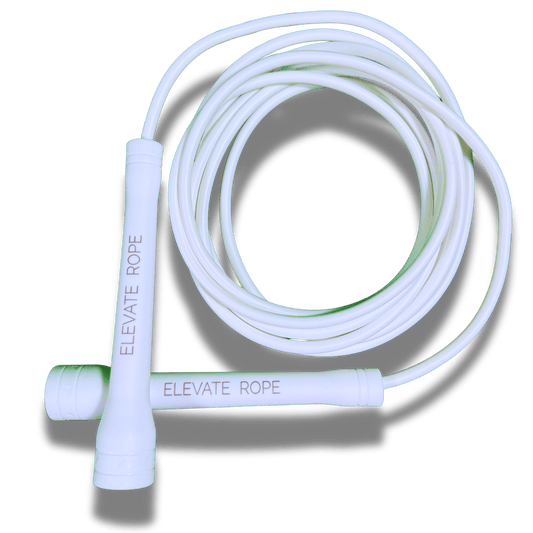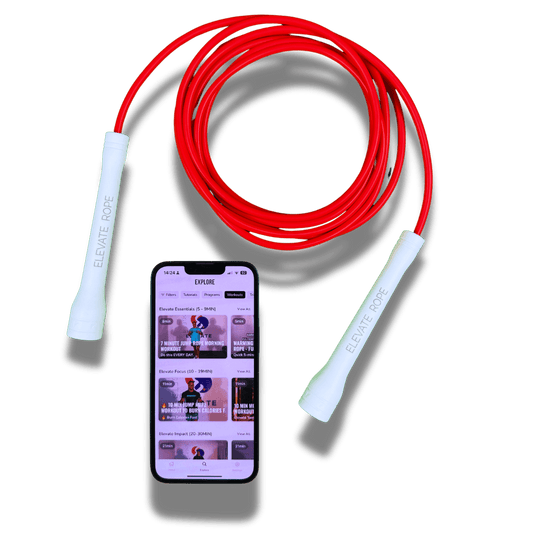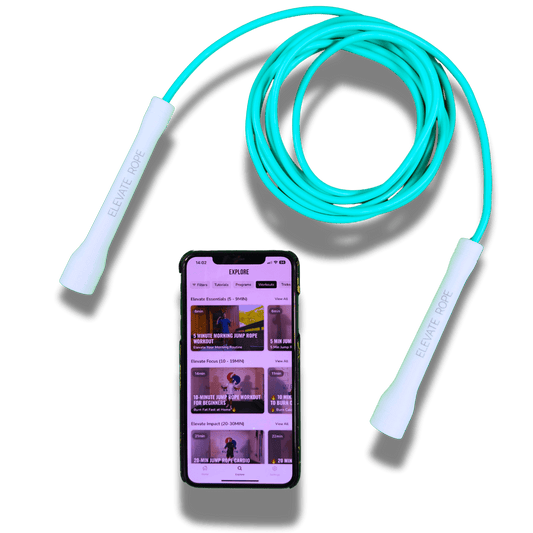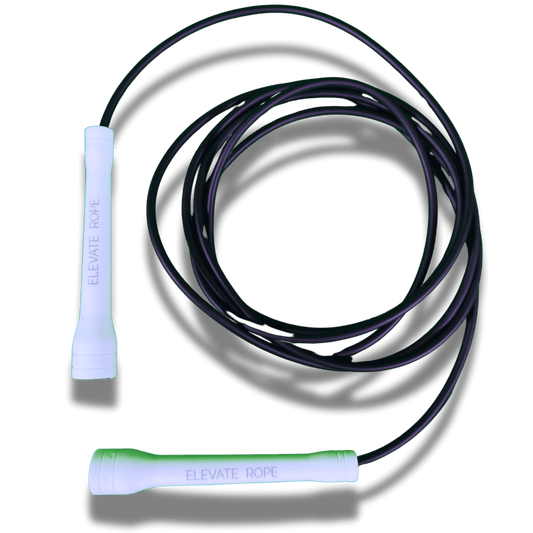If your calendar looks like a war zone of meetings, deadlines, and errands, squeezing in a workout can feel impossible. Cardio is often the first thing to go when life gets hectic. But skipping movement isn’t the solution — choosing smarter cardio is.
That’s where this classic showdown comes in: jump rope vs running. Two effective forms of cardio. Two very different vibes. And one big question:

What’s the best cardio workout for busy people who want results without the time drain?
Spoiler: it’s not just about calories or convenience — it’s about choosing the form of fitness that fits your real life, your goals, and your body.
Jump rope and running both have loyal fans. Runners love the meditative rhythm, fresh air, and endorphin rush. Jumpers swear by the efficiency, full-body burn, and fun factor.
But when you compare them side by side, especially from the perspective of a busy professional or parent who wants to stay fit without losing hours — jump rope starts pulling ahead. Fast.
In this blog, we’ll compare jump rope and running across seven categories:
- 🔥 Time efficiency & calorie burn
- 🦵 Joint impact & injury risk
- 🏠 Accessibility & convenience
- 💸 Cost of gear & maintenance
- 💪 Full-body muscle activation
- 🧳 Portability for travel or tight spaces
- 🎯 Overall recommendation & who it’s best for
Let’s get into it — and help you make the smartest cardio decision for your lifestyle.
Time Efficiency: Which One Burns More Calories, Faster?
Let’s start with the question every time-strapped person wants answered:
“How do I burn the most calories in the shortest amount of time?”
Here’s the truth:
- Jump rope burns up to 16 calories per minute
- Running (at 6 mph) burns about 10–12 calories per minute
That means a 15-minute jump rope workout can rival (or even beat) a 30-minute jog in terms of energy expenditure. Especially when combined with HIIT-style intervals, jump rope becomes one of the most calorie-dense forms of cardio available — no treadmill required.
So if you want maximum fat burn in minimum time, the rope wins round one.
Want proof? Try our Jump Rope HIIT workout and feel the burn yourself.
Joint Impact: Which One Is Safer for Long-Term Health?
One of the most overlooked aspects of cardio isn’t what it does for you — it’s what it does to you.
Running is powerful for your heart and lungs, yes. But it’s also high-impact, especially if you’re pounding pavement a few times a week. The repetitive motion places stress on your knees, hips, and ankles. Runners often deal with shin splints, knee pain, or plantar fasciitis.
Jump rope, on the other hand, might seem intense — but it’s actually gentler on your joints than running when done right. Why?
- You’re landing on both feet simultaneously
- The jumps are smaller and lighter
- You can control surface impact (especially with a jump rope mat)
- There’s less heel-striking and more forefoot landing
When you add in proper footwear and soft surfaces, jump rope becomes a low-impact, high-reward workout that’s easier on your body over the long term.
🧠 Tip: Start slow. Learn proper form. Let your body adapt. Like running, too much too fast can lead to overuse — but with good progression, jump rope is far more forgiving than it gets credit for.
👉 Bonus: Want to protect your joints while jumping? Use the Elevate Jump Rope Mat. Your knees and floor will thank you.
3. Accessibility & Convenience: Which One Fits Real Life Better?
Picture this:
You’ve got 20 minutes between Zoom calls. The weather outside is trash. Your gym is across town. What now?
Running in that moment? Probably not happening.
Jump rope? You’re good to go in seconds.
All you need is:
- A rope
- About 4x4ft of space
- A surface to jump on (indoors or out)
You can jump rope in your living room, garage, hotel room, or even your backyard patio. It’s the ultimate portable workout — and unlike running, weather and location don’t matter.
For busy people juggling unpredictable days, this convenience is everything.
Even better? No need to “gear up” with warm-up miles or stretch for 10 minutes before you feel the burn. With jump rope, you’re sweating in the first 60 seconds.
So when it comes to everyday accessibility, jump rope doesn’t just win — it dominates.
Cost Comparison: Shoes vs Rope (and What Really Pays Off)
Let’s talk about money. Because whether you’re on a budget or not, everyone wants value.
Running seems “free” at first, but let’s break it down:
- A decent pair of running shoes = €100–€180
- You’ll need to replace them every 500–800 km (or every 6–12 months if you run often)
- Add in sweat-wicking clothes, cold-weather layers, headphones, hydration gear… it stacks up
Now compare that to jump rope:
- A high-quality beaded jump rope = around €30–€40
- A jump rope mat = optional but useful, €40–€60
- Both will last you years, even with daily use
In short: Jump rope wins on durability and cost-efficiency. And there’s no “hidden gear” you’ll find yourself needing later. No weather-specific layers. No mileage-based upgrades.
Want maximum fitness with minimal investment? The rope pays off again.
💡 Pro tip: Try our Beaded Ropes — they’re beginner-friendly, ultra-durable, and perfect for freestyle or HIIT.
5. Full-Body Activation: Who Trains More — the Runner or the Jumper?
Running is a great way to strengthen your lower body and cardiovascular system. But in terms of muscle engagement, it’s pretty limited:
- Quads
- Hamstrings
- Calves
- Glutes (to some extent)
- Some core stabilization
Compare that to jump rope:
✅ Shoulders & forearms (rope control)
✅ Core (balance, rotation, stability)
✅ Calves & glutes (jumping and power)
✅ Posture muscles (to stay upright & aligned)
✅ Brain (timing, coordination, rhythm)
Every jump trains your mind-muscle connection, while also building lean strength across your entire body. It’s cardio + skill + strength in one compact form.
And let’s not forget variety:
- Criss-crosses? Upper body.
- Double unders? Core and coordination.
- Side swings? Shoulders.
- Freestyle combos? Everything.
No other cardio tool hits this many systems at once while still keeping it fun and efficient.
Jump rope turns your whole body into a fat-burning, agility-building engine — without needing weights or machines.
Travel & Time Flexibility: What Wins When You’re Always On the Move?
If you travel often for work, juggle parenting, or just don’t have the luxury of a fixed gym schedule, your workouts need to move with you.
Let’s start with running.
To run, you need:
- Decent weather
- A safe, flat route
- Enough time to warm up, get into your rhythm, and cool down
- Proper shoes packed if you're traveling
That’s already a list of requirements. Now imagine you’re in a city you don’t know, it’s raining, and you’ve got 35 minutes before a meeting.
❌ Running probably isn’t happening.
Now let’s look at jumping rope:
- Fits in your carry-on
- Needs just a few square feet
- Delivers full-body cardio in 10–20 minutes
- Weatherproof (indoors or out)
Whether you’re in a hotel room, parking lot, park, or office — jump rope just works.
No scouting routes. No dangerous intersections. No excuses.
It’s the perfect option for busy schedules, digital nomads, parents, entrepreneurs, or side hustlers who can’t waste time or energy figuring out where and how to work out.
The Final Verdict: Which Cardio Is Better for Busy People?
Both running and jump rope have their place. But let’s be honest — you’re not choosing based on theory.
You’re choosing based on:
- Time
- Energy
- Results
- Simplicity
- Sustainability
Here’s the breakdown again:
| Feature | Running | Jump Rope |
| Calorie Burn | High (but takes time) | Extremely high in less time |
| Joint Impact | High (knees/hips) | Low with proper form |
| Portability | Low | High |
| Gear Cost | Moderate–High | Low |
| Full-Body Engagement | Moderate | High |
| Time Efficiency | Requires longer duration | Results in 10–20 min |
| Travel-Friendly | Limited | Extremely flexible |
| Skill/Challenge | Low variation | High skill progression |
So, if you:
- Want to get fit faster
- Need workouts that fit around your schedule
- Prefer gear that’s affordable and lasts
- Like the idea of cardio that builds full-body coordination and muscle
- Want something that’s fun and keeps evolving
Then jump rope is your best cardio choice — hands down.
🎯 Start Jumping Today — for Free
Not sure where to begin?
Try Elevate14 — our free 14-day jump rope challenge that’s built specifically for busy people like you.
You’ll get:
- 20-minute follow-along videos
- A full-body burn in half the time
- No gym or experience required
- Fast results you can actually feel
🔁 Related Blogs You’ll Love
- How Many Calories Does Jump Rope Burn Compared to Running?
- Why Jump Rope is the Best Workout for Busy People
- Jump Rope: The Underrated Cardio King
- Can You Lose Belly Fat Jump Roping Every Day?
- Jump Rope HIIT: How to Burn More in Less Time
🎥 Train Along with Geraldo Alken on YouTube
Follow workouts, learn new tricks, and stay motivated with Geraldo’s videos:
👉 https://www.youtube.com/@GeraldoAlken/videos














